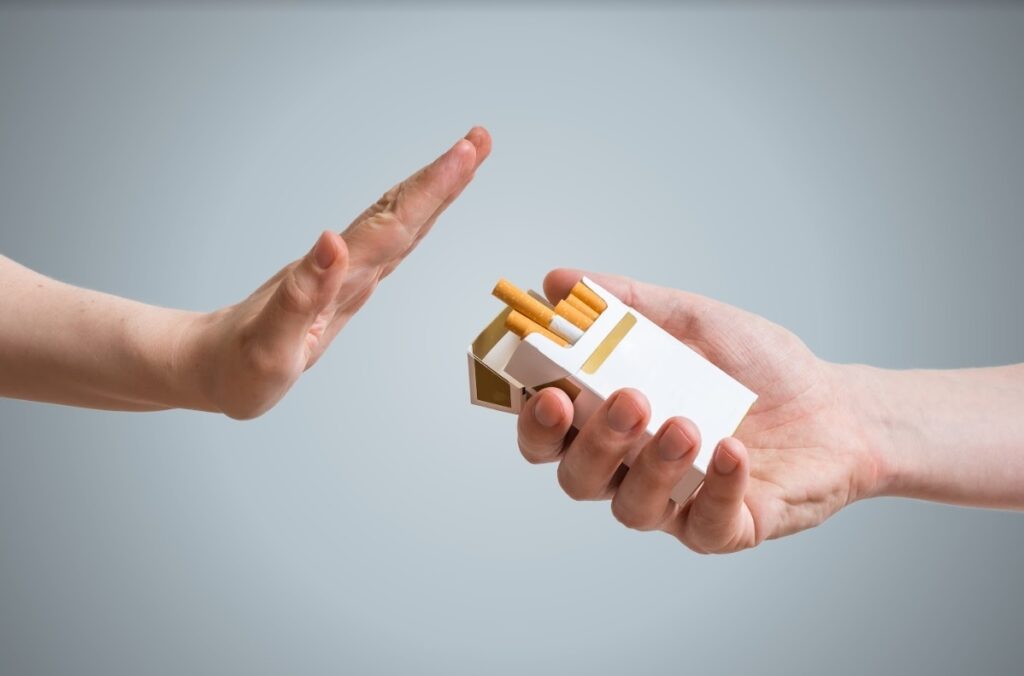Nicotine has been a part of human culture for what is estimated to be over 2,000 years. It originates from the plant “Nicotiana Tabacum” or as we all know it, tobacco. The substance has been used as both a medicine and stimulant by different cultures for almost as long as history has been recorded.

EDGE Vaping has been working with nicotine for many years, and wants to help people find an alternative to smoking. Their team has compiled this comprehensive look into the history and science of nicotine, so their customers can make an informed decision before choosing to vape, consume nicotine another way, or simply not use it at all.
Whether you are a smoker or vaper, it is important to understand the nature of the substance that keeps us tied to our habits. You might even be surprised to discover just how long and complicated it’s history with humans has been.
What is Nicotine?
Nicotine is the highly addictive compound found naturally within the tobacco plant. Nicotine represents around 5% of any given tobacco plant’s total weight. Despite only making up such a small part of the plant material we smoke, it is nicotine that keeps people smoking even when they might want to quit.
Nicotine is an organic compound and belongs to a group of substances called alkaloids. Alkaloids are compounds that contain nitrogen, which are known to have marked physiological effects on humans. In fact, nicotine has been classified as a stimulant, much like caffeine or cocaine. Stimulants excite bodily functions, in particular, the brain and central nervous system. They are known to induce alertness, elevated mood, wakefulness, increased motor activity and a decrease in appetite – all effects synonymous with smoking.
Where Did Nicotine Come From?
Consumption of the tobacco plant has been prolific in human cultures for a long time, first being utilised by indigenous tribes as a part of medicinal ritual ceremonies. The tobacco plant itself is native to the Americas. While it is not known exactly how it reached European shores, it is believed to have been brought back by Christopher Columbus, who settled in Portugal for a time in the 1400s following his famous first expedition to the “New World”.
Both the plant and the compound nicotine itself are named for Jean Nicot. He was a French ambassador to Portugal who, in 1550, sent tobacco seeds to Paris for cultivation. A crude form of nicotine was known to scientists by 1571.
In 1828, nicotine was first isolated from the tobacco plant in its purest form by Dr William Heinrich Posselt, and chemist Karl Ludwig Reinmann. These German scientists were the first to identify nicotine as a poison. Despite this discovery, the invention of the first patented machine for mass-production of paper cigarettes caused tobacco consumption to explode in 1880.
It wasn’t until these later stages of the 19th century that lawmakers began to recognise the harmful effects of nicotine, banning tobacco sale to minors in 26 US states by 1890. However, it wasn’t until as recently as 1964 that the US surgeon general published a study linking smoking with heart disease and lung cancer. With the US Food and Drug Administration (FDA) only officially recognising nicotine’s addictive properties by 1994.
How Do We Absorb Nicotine?
When tobacco is smoked, a nicotine patch is applied, or gum chewed, the nicotine passes through your body’s biological membranes. These membranes are in your mouth and lungs primarily; however, in the case of patches, the nicotine is absorbed dermally (through the skin), ending up in your bloodstream. From here, it is delivered to various parts of the body. Nicotine is particularly well-absorbed by the brain, taking only around 10-20 seconds to reach it after taking a puff on a cigarette.

How well nicotine is absorbed by a person can depend on a surprising number of factors beyond just the delivery method. Race, gender, and age have all been observed to impact absorption rates and metabolism. People of African descent, for example, were observed to clear nicotine levels slower than those of white ethnicity, meaning it remains in their system for longer. People of Chinese descent were also recorded to absorb less nicotine per cigarette than those of Latin or white descent. Indeed, it has even been observed that women metabolise nicotine faster than men.
Nicotine Addiction
As a stimulant, nicotine is a part of the family of drugs considered to be among the most habit-forming. Delivering short-term benefits to a person’s mood and sense of wellbeing, while simultaneously creating conditions to the contrary; a person may smoke to relieve stress, without realising the withdrawal effects of nicotine are actually driving them to smoke in the first place.
There has been a massive number of studies carried out investigating the addictive nature of nicotine, with scientists constantly amazed by how powerful it can be. One researcher, Dr Daniel McGehee, stated that “it would be difficult to design a better drug than nicotine to promote addiction”.
The National Institute for Drug Abuse (NIDA) funded research at the University of Chicago, which found that a major part of nicotine’s addictiveness lies in its double action upon the brain. It directly stimulates the feelings of pleasure in the brain, while indirectly preventing those feelings from lasting very long or coming on very strong.
In this way, nicotine toys with your brain’s reward system, causing you to crave the satisfaction of a cigarette, for example, while chemically ensuring the joy will be short-lived, leading you to consume more and more in pursuit of a dwindling pleasure.
Once it reaches your brain, nicotine binds to special neurons and causes them to produce the neurotransmitter dopamine. Dopamine is not only responsible for feelings of pleasure, but also drives our desire to repeat behaviours that led to that pleasure. For example, drinking water when thirsty is a universal example of this action-reward relationship. When we drink to quench our thirst, our brains are flooded with dopamine that gives us satisfaction and reinforces that this was the correct response to our situation, making us want to do it again if the same circumstances arise.
Nicotine takes this relationship to the next level, which is why it is so powerfully addictive. NIDA discovered that dopamine levels triggered by nicotine remain high even after the direct stimulus (smoking, for example) ends. This means that the desire to repeat behaviour like smoking is even stronger than natural causes vital to survival like drinking water.
Nicotine Damage and Withdrawal
Nicotine when isolated and in the quantities most people would normally consume is actually a well-tolerated substance. While links to cancer exist, they are not well substantiated. Modern experts theorise that nicotine is no more likely to cause cancer than caffeine.
Studies in human trials have struggled to prove that nicotine (exclusively) causes increased risk of cancer. It is believed the delivery method and the additional chemicals consumed while using them carries the greater risk, such as those in cigarettes and to a lesser extent, vaping.
While nicotine replacement therapies (NRTs) only deliver small amounts of nicotine, they can pose a risk, with tobacco posing the greatest risk of not only physical harm but of forming addiction. Long-term use can lead to any number of the above issues developing. Even in the slightest cases, nicotine withdrawal can lead to headaches and fatigue.
Nicotine was also found to reduce a person’s natural immune response and increase their risk of respiratory and cardiovascular disorders, in addition to the negative impacts on reproductive health. Worse still, a significant number of studies also linked nicotine to cancer, which is unsurprising given the known risks of smoking; however, the majority of this risk comes from the additional chemicals in cigarette smoke, rather than nicotine by itself.
Physical Withdrawal Symptoms
Appetite
Within a day or so of your last cigarette, your appetite will shoot up for a while. Nicotine binds to receptors in the brain that release dopamine and serotonin. These two chemicals reduce hunger, so when they’re out of your system you’ll want to eat more. A lot of people also find that they eat to fill the time they used to spend smoking. Most people gain about five to 10 pounds as they try to quit smoking.

Cravings
Nicotine cravings are the symptom you will deal with the longest, and they could start just 30 minutes after your last cigarette. An average craving will last only about 15 to 20 minutes, but they are persistent.
Headaches and dizziness
These are usually mild and are often the first withdrawal symptom to show up and taper off.
Fatigue
Nicotine is a stimulant, so you’ll probably feel tired without it. You may also be restless and might have insomnia.
Constipation
For the first month of abstaining from nicotine, constipation can be another unpleasant side effect.
Mental Withdrawal Symptoms
Anxiety
The nicotine delivered when smoking is widely perceived to relieve stress. When quitting, this can cause your anxiety to skyrocket as you are defying your brain’s desire to repeat the behaviour that gave you such a powerful chemical reward.
Depression
for the same reasons as anxiety, suddenly removing nicotine from your life can lead to feelings of depression. While these are generally gone within a month, those with a history of anxiety and depression may require extra support.
Irritability
As a result of the physical symptoms of withdrawal, it is common for a person to have a very short fuse. This can cause you to become angry at the slightest thing; however, this is normal and should pass with time.
Mental Fog
As the nicotine slowly leaves your body, many people have expressed a difficulty concentrating and remaining focussed on everyday tasks.
Timeline of Nicotine Addiction
- 30 minutes to four hours: The initial effects from the nicotine will wear off and you’ll start to crave another cigarette.
- 10 hours: You will be very restless, physically craving a cigarette, and wondering how to fill the time. You may feel sad and hopeless.
- 24 hours: Irritability will kick in and your appetite will increase.
- Two days: You’ll likely have headaches as the nicotine leaves your system.
- Three days: The nicotine should be gone from your system at this point. Your cravings should taper off but anxiety may start to rise.
- One week: Pat yourself on the back, you’ve made it through the worst. Avoiding triggers is vital to avoid relapse.
- Two to four weeks: You still won’t have much energy, but any mental fog should be clearing, and your appetite will settle down. Your cough, depression, and anxiety should also improve.
- Five weeks on: With most physical symptoms behind you, the key is now remaining strong mentally.
Are You Worried About Your Nicotine Consumption?
If you are a smoker looking for an alternative or a new vaper who wants to work their way down through nicotine strengths, there are multiple impartial resources available to support you.
Author
Article By Caitlin McCarthy, Formulations Technologist at EDGE Vaping